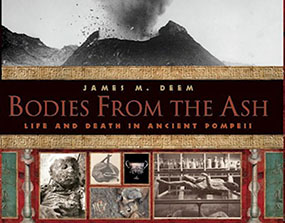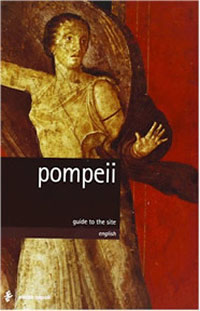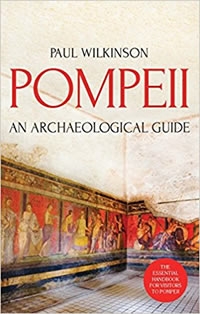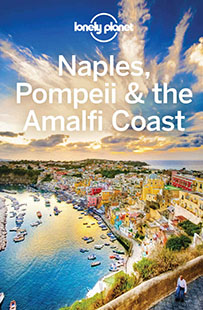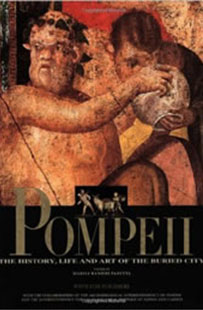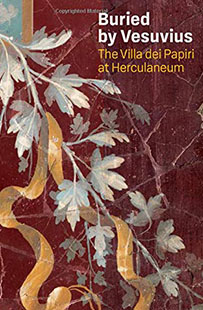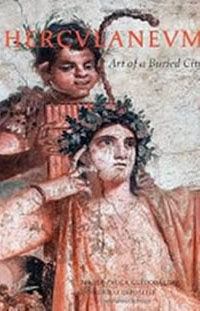Hardcover edition, 2005.Paperback edition, 2017.
|
~~ Suggestions for Visiting Pompeii ~~ ~~ Pompeii's Garden of the Fugitives ~~ ~~ Related Books by James M Deem: Bodies from the Ice ~~ Bodies from the Bog ~~ Faces From the Past ~~ |
Visiting Pompeii
I have visited Pompeii seven times, most while I was researching my book, Bodies from the Ash: Life and Death in Ancient Pompeii. Based on my visits, I can offer the following suggestions for having a memorable experience:
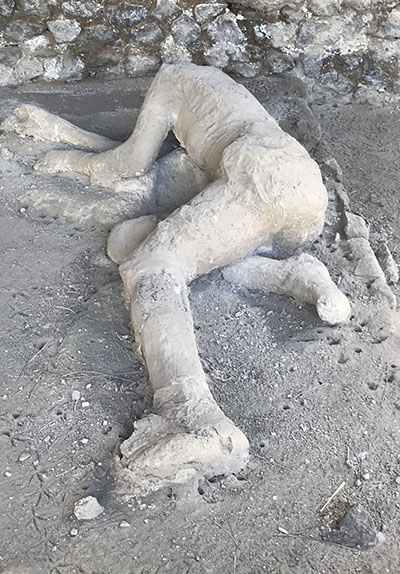 When to arrive. To avoid the throngs of tourists, plan to arrive shortly before the ruins open at 8:30 a.m.
When to arrive. To avoid the throngs of tourists, plan to arrive shortly before the ruins open at 8:30 a.m.
Where to stay. It is most convenient to stay nearby, especially if you want to enter the ruins at opening time. There are many convenient hotels in the vicinity. If you choose to stay elsewhere (such as in Sorrento or Naples), you can either drive to Pompeii and park (there are many parking lots across from the Porta Marina entrance for about 5 euros a day) or you can take the Circumvesuviana train.
How to get there by train: There are two Circumvesuviana stations in Pompeii, each serving a different line of the train: (1) If you come to Pompeii from Sorrento or if you take the Sorrento line from Naples, your stop will be the Villa of the Mysteries station (Pompeii Scavi), which is directly across the street from Porta Marina, the main tourist entrance to the archaeological site; or (2) If you come from Naples on the Poggiomarino line, your stop will be the Pompeii City station, which is located in the center of modern Pompeii. In this case, you will walk straight out of the train station until you reach the cathedral square (you can't miss the imposing spire). Then turn right and walk along the tree-lined main street until you reach the Piazza Anfiteatro entrance.
Best time and place to enter the ruins. There is only one way to see Pompeii: Arrive shortly before the opening time outside the Piazza Anfiteatro entrance. This is the less popular entrance to the ruins and away from most tourists (who often arrive at the Porta Marina entrance). On the way to the ticket office, you will pass a large display of plaster casts--the archaeological remains of some victims of the eruption of Mount Vesuvius in AD 79.
When the ticket seller shows up, you will be among the few people waiting to enter the ruins. Using the excellent map that's provided free for visitors, you can stroll into the uncrowded southern and eastern part of the ruins through the Noceran Gate. Head for the Garden of the Fugitives and then walk as far east as you can to the palestra, the amphitheater and any of the streets along its north side. For the better part of an hour, you may be able to feel as if you are in Pompeii alone.
Reading about Pompeii. To make the most of any visit to Pompeii, you should do some reading first. Many people hold a number of misconceptions about the eruption in AD 79 (there wasn't any lava flow, for example) and the eventual discovery of the ruins. There are no museum-like information placards posted in the ruins, so unless you are knowledgeable about Pompeii or are on a guided tour, your visit may not be very meaningful (it may just look like one ruined building after another). I can recommend a few guidebooks to help you:
If you want more historical or art background on Pompeii, I recommend these books:
And if you are specifically interested in the plaster casts that have been created, I can recommend Pompeii's Living Statues, an academic but highly interesting account for adults. 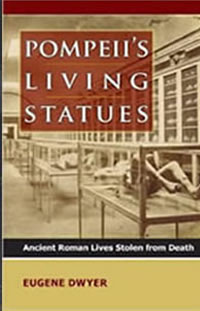 It gives a thorough history of the creation of the first plaster casts and includes descriptions of the discoveries and plaster creations taken from newspapers and letters at the time. It is excellent!
It gives a thorough history of the creation of the first plaster casts and includes descriptions of the discoveries and plaster creations taken from newspapers and letters at the time. It is excellent!
Another recommended book, for younger readers, is my own Bodies from the Ash: Life and Death in Ancient Pompeii. It provides a thorough introduction to the eruption of Mount Vesuvius, the rediscovery of Pompeii, and the creation of the plaster casts. The book explains both how they were made and how archaeologists deduced information about Pompeian life from them. The book also has many rare (and heretofore unpublished) photographs of the casts, taken from the Pompeii Archaeological Site's photographic archive.
What to bring with you. These days it costs around €11.00 to see the ruins. Unless you are a member of the EU, there is no discount for seniors or students. Still, a non-EU family of four can visit Pompeii for less than half the price of an adult ticket to many amusement parks which is not a bad deal. But once you enter, you cannot leave without paying again (there are no hand stamps). This means that you should be very organized:
1. Bring a large bottle of water (if the day will be warm) and perhaps something to eat. A cafe is located north of the Forum (along with a small bookshop) in case you want to eat in the ruins.
2. Don't forget your guidebook. Even if you have educated yourself about the ruins, a good guidebook is invaluable. Vendors sell them on the way into the ruins, but these are mostly just cheap tourist guides. You would be better served to buy one at the bookshop at the Porta Marina entrance, which sells a complete range of souvenirs and guidebooks..
3. Wear comfortable shoes. The main streets in Pompeii are treacherous with their undulating stones, and I have seen more than one person fall.
4. Plan to go back another day. There isn't enough time or human energy to see all of Pompeii in one day, and one visit just whets your appetite for more.
5. Bring a camera that works well in low light since many rooms are dimly lit. Be prepared for lots of tourists in your shots, unless you arrive early in the morning.
A Special Ticket: If you wish to visit both Pompeii and Herculaneum, you can buy one ticket (valid for three days) that allows entry to these two sites as well as Oplontis, Stabiae, and Boscoreale (the adult price of about €20.00 is a slight bargain if you plan to visit two sites, but a huge value if you will visit all five; note you can only visit each site once during the three days).
Eating a meal in Pompeii. The ruins offer only one cafe (a branch of the Autogrill chain found on the autostradas in Italy). You will enjoy your food more if you plan to eat outside the site in modern Pompeii, which is filled with tourist restaurants and one McDonalds (between the cathedral and the Piazza Anfiteatro entrance). A better alternative is a moderately priced restaurant, Carlo Alberti, on a street of the same name, just off the cathedral square. If you are on a budget, there is an adjoining storefront where you can order pizza to go; almost all pizzas were about €5 and worth every penny.
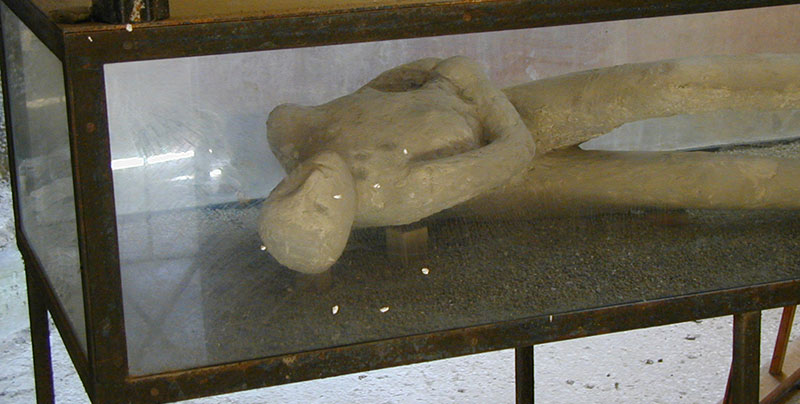
A plaster cast exhibited in the Villa of the Mysteries
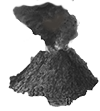
If you have made the trip to Pompeii, you should also plan to visit Herculaneum, Mount Vesuvius, and Naples:
Visiting Herculaneum
Herculaneum, or Ercolano, is a much smaller ruin than Pompeii and worth visiting for a look at a different kind of volcanic destruction. Unlike Pompeii, which was covered with some 10 to 12 feet of ash and volcanic debris when Vesuvius erupted, Herculaneum was overwhelmed by a flood of boiling mud that pushed back the shoreline by 400 yards and covered the town some 70-80 feet deep.
To visit Herculaneum, it is probably easiest to take the Circumvesuviana to Ercolano. When you exit the station, walk down the hill, following the main road until it ends at the bottom. The entrance to the site will be sign-posted.
Because Herculaneum is much smaller than Pompeii, it is relatively easy to see in half a day (note that there is no food service within the Herculaneum archaeological site itself). It is also much less crowded. As in Pompeii, some buildings will be closed, and many that are open will be in disrepair.
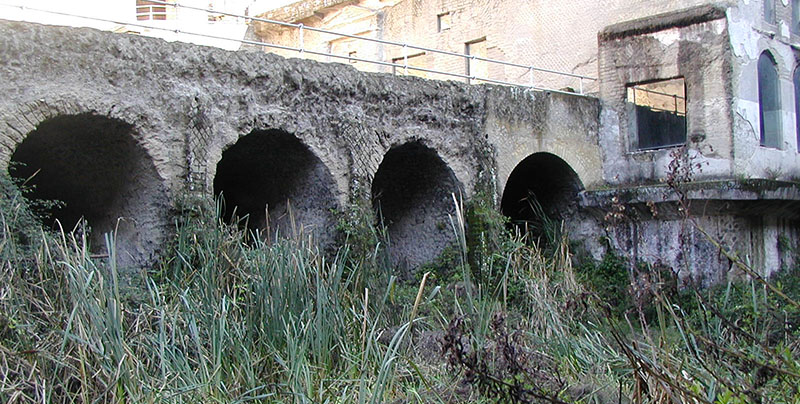
The boat sheds at Herculaneum, where over 300 skeletons were discovered in 1982
Visiting Mount Vesuvius
Mt. Vesuvius is a not-to-be missed stop on the grand tour of Pompeii. You want to make certain, therefore, that you plan your trip to crater carefully.
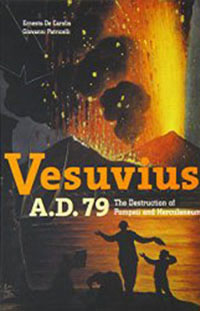 Since Vesuvius can be shrouded by clouds, allow yourself some flexibility in arranging your visit, but even on a foggy or hazy day, it is still worth a visit. if you'd like more information (that is, the real details) about the eruption of Mount Vesuvius in AD 79, the best book by far is Vesuvius AD 79 by Ernesto De Carolis and Giovanni Patricelli.
Since Vesuvius can be shrouded by clouds, allow yourself some flexibility in arranging your visit, but even on a foggy or hazy day, it is still worth a visit. if you'd like more information (that is, the real details) about the eruption of Mount Vesuvius in AD 79, the best book by far is Vesuvius AD 79 by Ernesto De Carolis and Giovanni Patricelli.
You can reach Vesuvius by car, taxi, or bus:
Arriving by car. Take the expressway (A3--Napoli to Salerno) to the Ercolano exit. You will see signs for the Vesuvius National Park. Follow the route markers to the parking lot (about halfway up the volcano). The road twists and turns, but it is not particularly dangerous. Still, be aware of the tour buses (especially those coming down the road around hairpin turns).
Arriving by taxi. If you take to the Circumvesuviana to the Ercolano station, you can hire a taxi from a lot directly outside the station. For a fare of around €15-20 (don't be afraid to bargain, especially if there are many taxis and business seems slow), the driver will take you to the parking lot below the crater.
Arriving by bus. You can also catch a tour bus (Trasporti Vesuviani) from the Ercolano train station or from Pompeii (near Pompeii Scavi station and the cameo factory); the price is much more reasonable. Since the buses run all day, you can return whenever it is convenient. Beware that the Ercolano bus stop is much less frequently used (and therefore can be skipped without notice) especially in the off season. If you don't want to miss seeing Vesuvius and have decided to take the bus, I recommend taking it from Pompeii to be certain.
No matter how you arrive at the parking lot, you still have a climb ahead of you. The path leading to the top is wide and steep, but it is not a difficult climb (except, perhaps, on a very hot day); occasional benches are provided for weary hikers.
When you arrive near the summit, you must pay an admission fee to continue your climb to the top (about €6.50 for adults). At the top, you can walk along the rim (though not too close) to an area that overlooks the ruins of Pompeii. Although Vesuvius is an active volcano, it does not emit any smoke. However, it is constantly monitored so that the millions of residents who live nearby could be warned in the event of an eruption.

The route along the rim of Mt. Vesuvius's crater
Visiting Naples
To complete your tour of Pompeii, plan to visit the National Archaeological Museum(Museo Archeologico Nazionale) in Naples. If you take the Circumvesuviana into Naples (and have purchased a one-day travel pass), you can use the Naples underground all day as well. Head for the Cavour station, which is the museum's stop. It is best to visit the museum after Pompeii, since you will be amazed (having seen the ruined buildings) at what was salvaged from them. The museum's Pompeii exhibits are breathtaking and include frescoes, statues, ornamental objects, and everyday items. It is simply not to be missed (closed Tuesdays).
And don't overlook the rest of Naples! It is also an unforgettable and special place.

A reconstruction of the skeletons found in Herculaneum's boat sheds is exhibited at the museum
